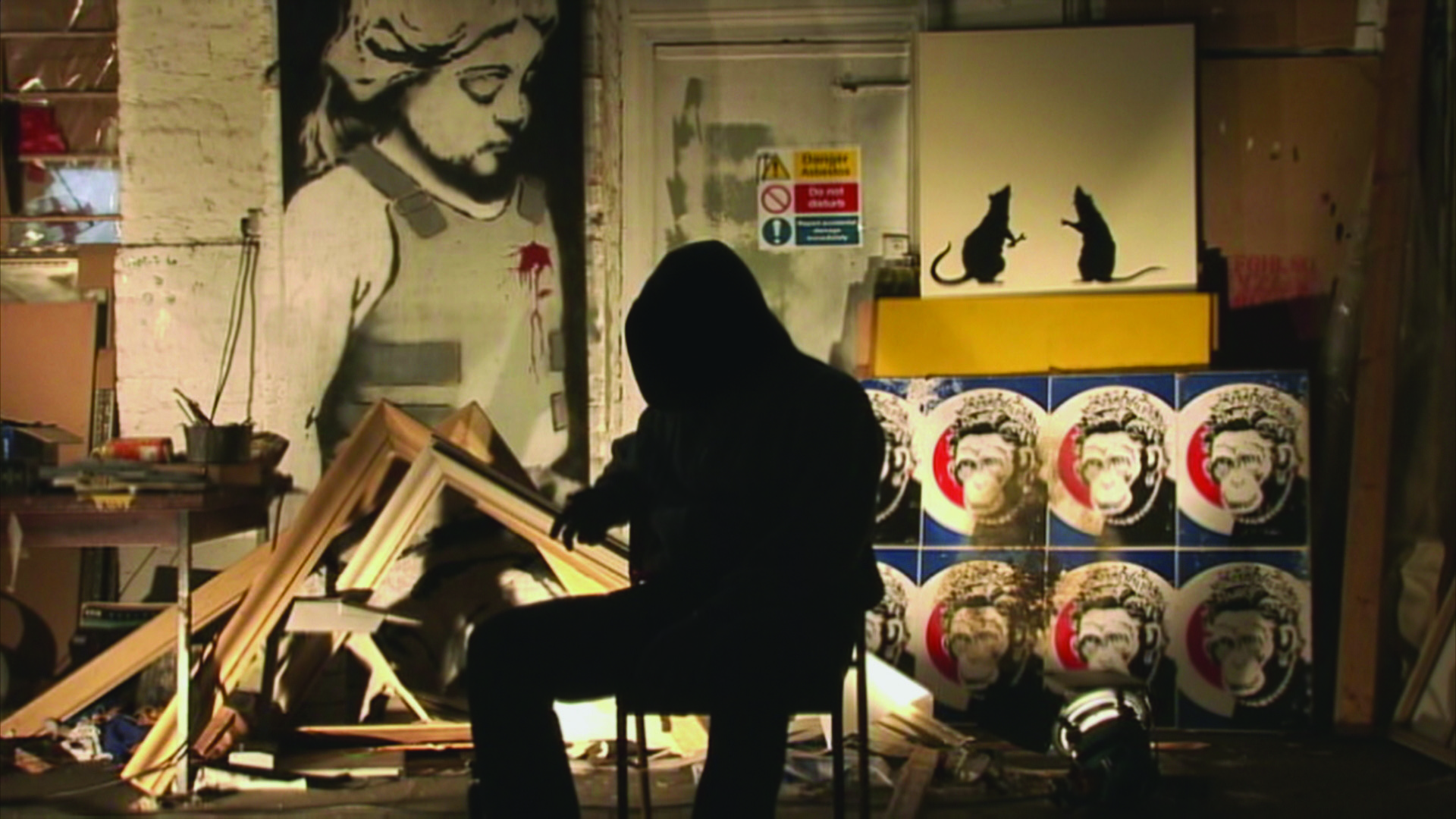
MPAA Rating: R | Rating: ★★★★½
Release year: 2010
Genre: Documentary Director: Banksy
A documentary film by the British street artist Banksy, Exit Through the Gift Shop tells a story so incredibly bizarre that it might not have actually happened. And maybe that’s the point.
Banksy didn’t actually film most of the footage (at least I think that’s true). No, much of this quirky and hilarious documentary was filmed by vintage clothing store owner Thierry Guetta. Thierry is a character no one could have created on their own. He’s a portly French guy with Civil War-era facial hair and a penchant for filming every aspect of his life. He’s quite entertaining to watch.
Thierry films. And films. And films. It’s an addiction, an obsession.
One day, he starts filming one of his Los Angeles graffiti artist friends. His addiction gains a purpose, giving it momentum to drive him to want to film more graffiti artists, including Shepherd Fairey, the artist behind the iconic Obama poster. Thierry begins following these guys around, climbing on rooftops, running from cops, plastering huge posters on the sides of buildings. He tells his subjects that he is making a documentary about graffiti artists, so they continue to let him tag along. Following the artists becomes an obsession, driving him to try to make contact with the most infamous graffiti artist in the world: Banksy.
All the while, Thierry holds the camera. This happens for years. And Thierry has no intention of ever editing the footage and making a film.
Banksy eventually figures out that Thierry is, in fact, a terrible filmmaker and a bit of a weird guy, so he suggests that Thierry try street art. This is when the film takes a dramatic shift in the second act, when the cameras are suddenly turned onto Thierry. We’re never told who is controlling the cameras, but I assume it is directed by Banksy. Thierry becomes obsessed with his own version of street art–having learned from the best, after all–and sets out to do his own ambitious art show highlighting his work, causing Banksy to reevaluate his relational ties to Mister Brainwash (Thierry’s artist name).
Like My Kid Could Paint That and Summer Hours before it, Exit Through the Gift Shopraises a significant cultural question: what makes art valuable? Perhaps the question behind the question: what is art?
In Summer Hours, a vase used by the estate housekeeper turns out to be a rare piece of art worthy of being placed in an elaborate gallery. She thinks it’s ugly, though useful around the house as a temporary container. In My Kid Could Paint That, people are paying thousands of dollars for paintings created by a four-year-old girl on her kitchen floor.
Is the vase more valuable for holding flowers in a living room or behind glass at a gallery? Would people still pay thousands for the paintings done by a four-year-old if they found out her father was really doing most of the work? Is Thierry’s artwork–hiring graphic designers to slightly manipulate or alter iconic pieces of popular art, then literally throwing his own signature on it–an ironic twist on street art or simply a sellable copyright violation?
The biggest question related to this documentary: is any of this even real? It’s been suggested that Exit Through the Gift Shop is an elaborate hoax, that Banksy is the artist and Thierry is the medium through which he creates this creative prank. If this is true, Banksy’s film is basically a subtle middle finger to movie audiences, much like Haneke’s Funny Games, only far more entertaining. I’m convinced Banksy’s answer to the question would be,does it really matter?
The film’s enigmatic title plays a vital role here: we leave an art gallery or museum through their gift shop. We’re expected to buy something to remind us of our experience. The art is not simply there to be enjoyed and appreciated; it is now a commodity to be purchased and consumed. Whether we like it or not, our culture defines value monetarily. And hype. And ambition. (James Cameron’s Avatar made over a billion dollars based on all of the above, not from its less-than-exquisite script).
I recall my experience seeing the Mona Lisa in the Louvre in Paris. The room was a madhouse, filled with a pulsating crowd of onlookers, all craning their necks for a glimpse of Da Vinci’s masterpiece. But what I really noticed were the cameras. Above the crowd were literally dozens of cameras and cell phones, arms raised high to get over the teeming masses in order to snap a quick picture. That picture is likely now someone’s past Facebook status. Were the picture-snappers really experiencing the beauty of Da Vinci’s artwork, fully engaging themselves with what the art communicated, the truths it revealed, noticing the subtle transcendent reflection of the Divine Artist? I doubt it. Maybe we’re missing something when anything beautiful has to be quickly sold and consumed to be considered valuable. (I wonder, too, about Christian art that simply copies what’s already been done before, and better. Shouldn’t the Church be the best at reflecting God’s creativity instead of reproducing what the culture already created?)
If we’re honest, we can discern that Thierry’s art isn’t really art. But it sells. In our culture, that makes it important enough to put on the front of LA Weekly. Los Angeles hipsters lined up for hours to see Mister Brainwash’s debut art show. Madonna had MBW design her latest album cover. Thierry must be on to something. At least Banksy is. Exit Through the Gift Shop is one of the more thought-provoking and entertaining films of the year. It caught me off guard (in a good way) and has me asking myself deepening questions about art and culture nearly a month later.
Now if you’ll excuse me, I need to go purchase some new art to decorate my office. Maybe they’ll have something cool at Target.
IMDB Listing: http://www.imdb.com/title/tt1587707/